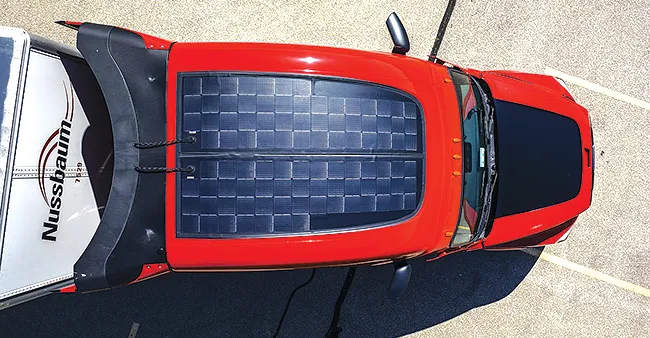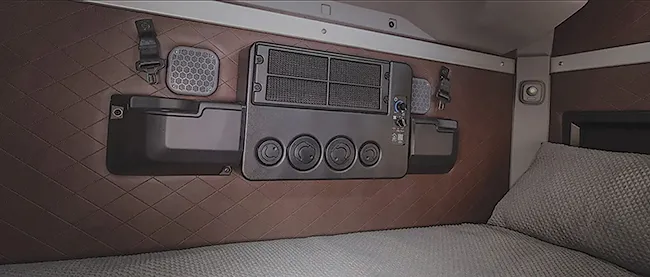Contributing Writer
What’s Now and Next for Auxiliary Power Units

[Stay on top of transportation news: Get TTNews in your inbox.]
In an industry that depends on moving forward, idleness is somewhat of a double-edged sword. Fleets have economic, environmental and regulatory considerations in setting their idling strategies. However, they are finding solutions for keeping drivers comfortable on their rest breaks while reducing idling time.
Knowing that comfort is a major factor in driver retention, trucking companies have taken action through their choices of auxiliary power units and approach toward idle management.
For instance, Nussbaum Transportation uses factory-installed battery-powered auxiliary HVAC systems, while Averitt has installed diesel-powered APUs to its lines. C.R. England is testing options in its operations.
Dave Schaller, industry engagement director for the North American Council for Freight Efficiency, noted one major fleet recently said it considers a truck with a current emissions engine to consume 1.1 gallons of diesel per hour while idling. In comparison, older, pre-aftertreatment engines burned 0.6 gallon.

Nussbaum has been outfitting all its trucks with solar panels to help charge batteries, starting with its 2019 models. (Nussbaum Transportation)
Virtually all of Nussbaum’s estimated 580 trucks are outfitted with Freightliner’s ParkSmart battery HVAC system. Tony Morthland, director of equipment and facilities, and James Grier, director of fleet service, said the systems along with the company’s strategies and driver training keep the cabs comfortable with limited idling. They said Nussbaum’s trucks average 6-7% idling time during a 10-hour rest break, with that number increasing to 14-16% in summer.
“We’ve got drivers with CPAP machines. We’ve got drivers that play video games, and they’re able to go 10 hours with that system,” said Grier.

Grier
Nussbaum uses other strategies to reduce idling time. It has been outfitting its trucks with solar panels to help charge batteries, starting with its 2019 models. Trucks are spec’d with extra insulation. The company also uses shore power for creature comforts and has installed 120 plugs at its headquarters.
Meanwhile, performance coaches train drivers to be more efficient. Because the APUs are better at maintaining a temperature than cooling a truck, drivers are trained to start blasting the AC into the sleeper before they park. Once parked, they cover the windshield and seal off the sleeper with curtains. Operations will help anyone with high idling time to create a game plan. One driver last year was at 77%. It turned out he didn’t know how to use his bunk air-conditioner. Now that he’s been trained, he’s usually around 10-15%.
“You just can’t throw a driver in one of these trucks these days and expect them to figure it out on their own without costing us a lot of money,” Morthland said.
Bergstrom supplies battery-electric climate systems to truck manufacturers, which then market the product under their own names. The company estimates a truck that drives 200 days a year will save $7,200 in fuel and maintenance costs.
Bergstrom’s NITE Phoenix and split NITE SSI system install under the bed with ducting alongside the back wall. Christophe Barreau, director of advanced technology, and Brett Herrmann, principal engineer, said the system can maintain 73 degrees for 10 hours, a Technology & Maintenance Council recommended standard. Some batteries use lead acid while others use absorbent glass mats. AGM batteries have a longer discharge depth, longer run time and longer life.
Herrmann and Barreau see a trend toward lithium, where research is happening and power density is improving. But they don’t know of any truck manufacturers going that direction yet.
“What we see more and more is they want a lithium-ion package,” Barreau said. “It’s more expensive, but it’s going to have a way higher life, and you can run your system longer with lithium-ion batteries because you can go almost down to zero state of charge.”

Seaburg
Recreational vehicle APU maker Dragonfly Energy entered the truck market about two years ago. Chief Revenue Officer Wade Seaburg said lithium batteries last longer than AGM and require less maintenance than diesel APUs. Seaburg said a lithium battery can go from dead to charged in 3½ hours and have enough juice to run a CPAP, air conditioning and other comforts the entire 10-hour rest break.
Volvo is using AGM batteries and investigating other types for its parking cooler. Chris Stadler, a product marketing manager responsible for the longhaul segment, said lithiums are lighter and last longer but cost more.
“As the cost and availability gets a little bit more in tune with what we need, I think that will be something for sure that we’ll look at bringing into our trucks,” he said.
Volvo’s new VNLs don’t have a separate battery pack for the parking cooler, which saves cost and weight. A battery management system will restart the truck if a charge is needed to ensure the truck cranks.
The new VNL trucks come with 24 volts, as the company’s models do in Europe. The extra power can handle the parking cooler and other needs, and can help the truck withstand the demands caused by vehicles’ increasing electronics. The reduced amperage generates less heat, so there is less wear on the wiring harness.
Other truck manufacturers also rely on battery-powered systems for their factory-installed offerings. Jake White, director of product marketing, said Peterbilt’s SmartAir system can maintain temperatures for a 10-hour rest break. He said the take rate is about 10%, while idle shutdown timers, APUs and fuel-fired heaters are popular. Brianna Potthast, Kenworth on-highway marketing manager, said the factory-installed Kenworth Idle Management System can run 10 hours and hold a temperature of 76 degrees.
Daimler Truck North America’s Mike Young, powertrain product marketing manager, said DTNA’s Dual HVAC provides up to 10 hours of cooling and 34 hours of heating before charging is needed. He said optional systems including ParkSmart systems and Espar heaters are in the vast majority of trucks built.
Young said take rates at the factory level have remained at a steady high level the past few years with battery-powered systems on the uptick.
“Regardless of the rules and their impacts, most fleets have already heavily addressed extended periods of idling on their own in one way or another, and we are proud to have many tools available across engine characteristics and factory-installed options to allow fleets to configure the best solution for them,” he said.
While Nussbaum uses a factory-outfitted battery-electric system, Averitt uses Thermo King TriPac diesel auxiliary power units it purchases directly and installs itself, maintenance manager Shane Nelson said.
“That piece of equipment is installed on every single sleeper that we have,” he said.
Nelson said the Thermo Kings run the entire 10-hour rest break, which he said battery-powered systems won’t achieve. Battery-powered APUs haven’t cooled as well as the diesels, and there can be issues with battery longevity and field availability.

Mack offers a factory-installed electric Auxiliary Power Unit for its 70-inch Mack Anthem sleeper model. (Mack Trucks)
As for alternative power sourcing, Mack Trucks offers its 70-inch Anthem Sleeper, an optional electric auxiliary power unit, via its partnership with Phillips and Temro and is its “idle free” system.
“This system supplies power to the truck, but using batteries instead of consuming fuel,” said Blake Routh, Mack’s senior highway product manager. “This means the driver is able to use many of the amenities in the truck, including climate control and electric amenities, but without the cost of idling the engine.”
With electric, Routh added, fleets are looking for alternatives to engine idling, but without sacrificing performance. For the driver, it means keeping the sleeper cabin at a comfortable climate while not driving.

Routh
“More fleets are looking to move to idle-free solutions as this is a great way to reduce fuel consumption, without sacrificing driver comfort,” he said.
Averitt is testing an optimized idle/battery APU combination and has dabbled in other systems. It would not be opposed to battery-electrics if one were functional, safe for technicians, easily learned and with parts available, Nelson said.
“We look forward to what the future holds,” he said. “We’re always excited about new technology and the utilization of it in our fleet and trying to be on the cutting edge of it and getting it out there for our drivers to utilize and benefit from it. It’s fun.”

Vance
Unlike battery-powered systems, diesel-powered systems use fuel, although much less than a truck would use idling. Charlene Vance, director of product management for APU at Thermo King, said an APU burns about 0.28 gallon per hour versus an idling truck burning a gallon. Over a typical ownership period, that equals about 10,000 gallons saved.
Diesel-powered APUs have many of the same components as truck engines and require maintenance, which has been an issue for some fleets. NACFE’s Schaller said a popularity spike in the technology led to bad products that damaged the APU’s reputation. A fleet executive once said it had more shop floor space and mechanics dedicated to its APUs than its truck engines. But those manufacturers with flawed products have left the market.
Thermo King’s Vance said the APU market is “robust and steadily growing.” She said the APU’s 24 months of complimentary telematics can tell fleet managers about APU run hours and cabin temperatures and can automate fuel tax reporting.
Green APU is another diesel APU provider. General Manager Greg Ciszek and Director of Customer Support Eric Davis said the company prioritized overall cost of ownership and ease of maintenance by using nonproprietary and automotive-based parts that can can easily be sourced at an auto parts store.
The two said a diesel-powered APU can cool the cab throughout not only the 10-hour rest break but also the 34-hour reset. In contrast, they said battery APUs don’t keep a driver cool for 10 hours, which leads to idling.
C.R England has been reviewing idle technologies for more than a year, said Ron Hall, vice president of equipment and fuel.
The change came after the company started transitioning five or six years go from being a training fleet to an experienced driver fleet and from a largely over-the-road fleet to more of a dedicated fleet. Those changes led to a reduction in its team count and an increase in on-road idling.
McLeod Software CEO Tom McLeod explores the potential for artificial intelligence to boost efficiency and build resilience. Tune in above or by going to RoadSigns.ttnews.com.
The company compared four options over a full year: 100 DClimate battery-electric APUs; 100 manufacturer-installed APUs; 250 trucks configured for optimized idle comfort mode that automatically starts and stops the truck based on demands; and standard parameters that do not allow for idling when ambient temperatures are between 20 degrees and 70 degrees Fahrenheit.
Hall said the DClimate electric APUs performed better, followed by the factory-installed option and then optimized idle.
“Even when ambient temps are in the 90s, we’re still getting the units giving us hours of AC,” he said of the electric APUs, adding the fleet is probably is getting six to eight hours of performance before the truck has to idle.
Now, C.R. England will consider costs. The company a couple of years ago tested two diesel APU products, determining there was insufficient return on investment because of maintenance and fuel costs.
Want more news? Listen to today's daily briefing above or go here for more info
The company coaches its drivers on idle management techniques, including parking in the shade. It also is monitoring and counseling drivers with high idle percentages.
Routh noted that with electric APU technology changing and ultimately improving performance, he anticipates it will reflect increased adoption.
“Diesel APUs continue to be the majority share of APUs,” he said, “but as performance with electric APUs is increasing, we’re seeing more and more interest from fleets to migrate toward electric APUs.”



